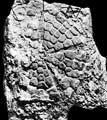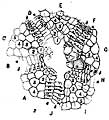The Echinoid Directory
Contributed by Andrew Smith, January 2012
Perischodomus McCoy, 1849, p. 253
[?=Koninckocidaris Dollo & Buisseret, 1888, p. 959, type species Koninckocidaris cotteaui Dollo & Buisseret, 1888; =Tretechinus Tornquist, 1897, p. 784, type species Perischodomus illinoisensis Worthen & Miller, 1883 ]
| Diagnostic Features |
|
|---|---|
| Distribution | Lower Carboniferous, USA, Europe. |
| Name gender | masculine |
| Type | Perischodomus biserialis McCoy, 1849, p. 253, by original designation. |
| Species Included |
|
| Classification and/or Status |
|
| Remarks |
|




